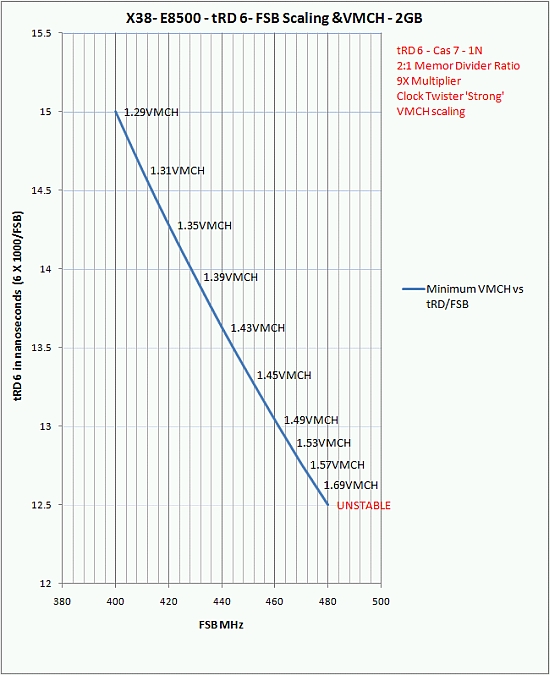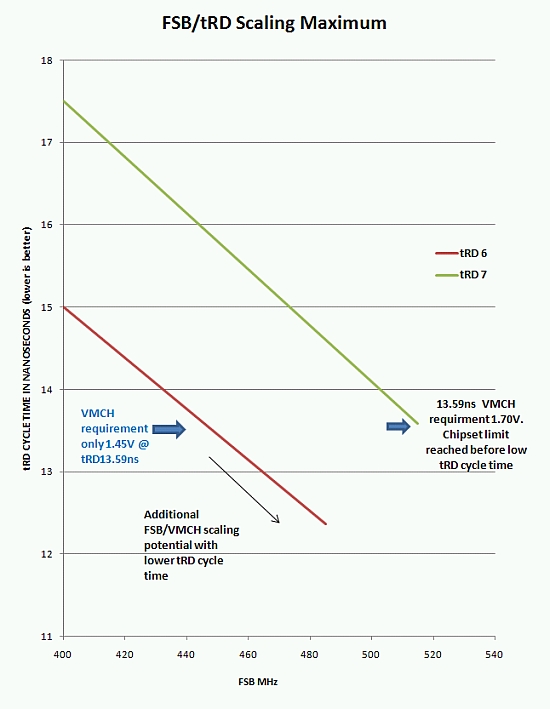Intel X38 Tango - Is High FSB Overclocking Worth It?
by Rajinder Gill on February 26, 2008 3:30 AM EST- Posted in
- CPUs
The Calculator Hustle
The first aspect of why we believe higher FSB rates are not always better for system performance can be shown using the following calculation to find the actual tRD time in nanoseconds:

We first dissected this equation in our Asus Rampage Formula article, and it remains true today. To recap, a lower tRD time yields faster read data transfer between the memory and CPU.
If we use the equation above to study the actual tRD values at 500FSB and 445FSB, we will see that using a tRD of 6 actually results in a lower tRD delay cycle. This is exactly why the somewhat sensitive UT3 graphics engine shows a discrepancy in 8x500 performance at a higher tRD of 7 (graphs are on page 4) as one example. We notice the same pattern in any application that is latency sensitive.
In order to equal the tRD cycle time of 6 at 445FSB we can rearrange the equation above to find the equivalent FSB requirement at a tRD of 7 quite easily:
TRD6 @ 445FSB = 13.483ns
13.483ns / Experimental TRD (7) = 1.926ns
Therefore:
[1000/1.926ns] = FSB (519FSB)
Even if the CPU is capable of the additional 152MHz (using an 8x multiplier), the VMCH requirement to achieve a tRD cycle time of 13.48ns at 519FSB would quite simply be off the scale for 24/7 use. At 500FSB and a "Moderate" setting in the ASUS performance enhancing "Clock Twister" BIOS option, we already need 1.65VMCH and can't even begin to run games like Crysis or other applications such as Nero Recode 2. Yet 445FSB and a tRD of 6 still has enough overhead to allow further scaling if the processor is capable. It makes far more sense to make an attempt at 9X461, which is still within reach of our 1.65VMCH limit as shown in the graph below.

Not only is 461FSB possible, but we also manage to reduce the tRD cycle time even further - down to 12.93ns to be exact.

A tRD of 5 is not available on this board; even if it was, it would not be without side effects. The first problem is that 400FSB at a tRD of 5 gives us a tRD cycle time of 12.5ns. This is certainly great, but if we look at the graphs above, it is quite possible that such a low tRD cycle time would leave no remaining overhead in Northbridge voltage for scaling much further than 410FSB (tRD cycle time of 12.19ns). We verified the secondary setting by using the ASUS P5E3 Premium board we have in the labs (which has access to setting a tRD of 5). A tRD of 5 naturally requires the 2:1 memory ratio to achieve a speed of DDR3-1600; at CAS 6 this requires significant VDimm due to the very "tight" CAS latency. Increasing this setting to CAS 7 results in a large performance drop.
Let's take a look at the actual CAS (Column Address Strobe) memory latencies at various memory speeds to see what the optimum primary memory CAS value is for performance, voltage (VDimm), and system scaling potential.










15 Comments
View All Comments
AndyKH - Thursday, February 28, 2008 - link
When reading the article, I didn't find any info on how you adjusted tRD. I thought such adjustments weren't available in the BIOS except for certain X48 boards from ASUS (unless you resorted to FSB strap settings that might limit memory ratios). Is this setting beginning to show up on X38 boards as well?Rajinder Gill - Thursday, February 28, 2008 - link
There is a full BIOS guide for this board here (part of the full review).. 'Transaction Booster' is the function.http://www.anandtech.com/mb/showdoc.aspx?i=3172&am...">http://www.anandtech.com/mb/showdoc.aspx?i=3172&am...
regards
Raja
Aurhinius - Thursday, February 28, 2008 - link
I'd be interested to see something like this done with a Max formula board. Takes the X38 and pairs it with DDR2 rather than DDR3 which is still out of sensible reach for most people due to price.Then you can compare memory performance and settings on the same chipset with the two types of memory. Throw a quad in to the mix as well.
It's also going to illuminate any benefits (if there are any) of moving to an X48 platform from an X38.
Keep up the great work. These articles are a world apart from anything else I have seen and has people thinking how they evaluate their systems at all levels of experience.
Well done!
Rajinder Gill - Thursday, February 28, 2008 - link
A DDR2 version will be incoming, as well as X48 asap. We have a few reviews to get done first, but will try to incorporate this form of testing into them..regards
Raja
Zak - Wednesday, February 27, 2008 - link
Nicely written indeed but I gave up on overclocking, the real life benefits are not worth the effort. My 3GHz C2D runs at 3.6GHz easily with Tuniq Tower. Do I notice any difference in games? Photoshop? Nope. I used to get more excited about o/clocking I guess it passed with age:) Good luck to everyone though:)Z.
Nickel020 - Tuesday, February 26, 2008 - link
I quite like the recent articles, that kind of quality infos & analysis is very rare.I also liked the inclusion of some real world benchmarks, although the tRD article was great, I was missing some benchmarks demonstrating the real world effects.
Only thing is that DDR3 is still not an issue for most people, but the article is still well worth reading since since it explains underlying factors that affect performance.
menting - Tuesday, February 26, 2008 - link
the author questions why some memory manufacturers sell CAS9 DDR3-1900 as "performance memory" even though it means it has pitiful cas latency. The reason is that "performance" cannot be judged by cas latency alone. Sure with a low latency you can get a burst of data quicker, but with back to back reads on a memory, a higher clock speed is better. So it all depends how you want to look at it and how applications make use of the memory.Rajinder Gill - Tuesday, February 26, 2008 - link
Hi,I would still rather buy performance parts that scale to Cas 7 at ddr 1800 than Cas 9 at DDR 1900+. The FSB/tRD and VMCH requirements just don't make intelligent sense. Then we have the 2N command rate to play with when we begin to scale much past DR-1900. I would call it a lose-lose situation.
regards
Raja
Griswold - Tuesday, February 26, 2008 - link
Disco Stu likes the style of this article!Samus - Tuesday, February 26, 2008 - link
An unusually written article if I've ever seen one ;)